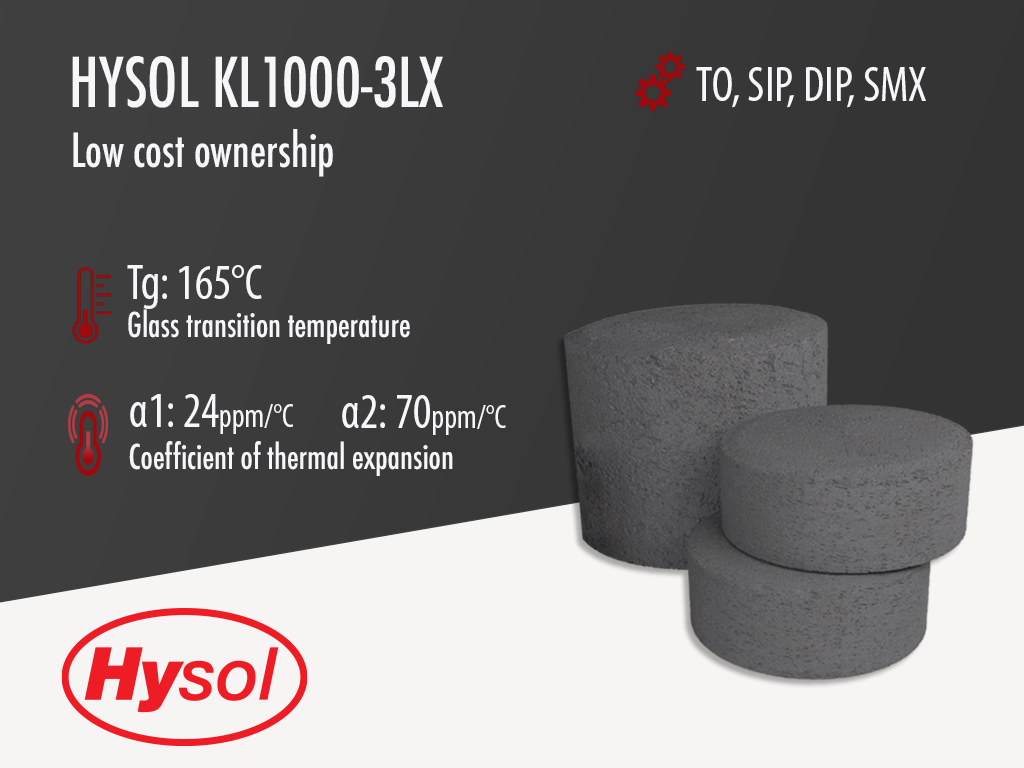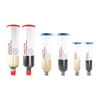Hysol KL1000-3LX | Black Epoxy Mold Compound
- High reliability
- High moldability
- Decreased cost-of-use
Product Description
Hysol KL1000-3LX is a black, semiconductor grade epoxy molding compound. It provides the lowest cost of ownership for an epoxy molding compound. It offers superior moldability and high reliability. This material is designed to satisfy JEDEC Level 4 requirements for reflow at 220 °C.
Hysol KL1000-3LX has a history that predates the acquisition of Huawei Electronics by Henkel. In 2005, Henkel formed a joint-venture with HuaweI Electronics in China to create Henkel Huawei Electronics (HHE) in Lianyungang China. HHE made low-end, halogen containing epoxy molding compounds that used Bromine or Antimony as a flame retardant. The KL1000-3LX is an old product that is still made at Hysol Huawei today. It meets UL94 V-0 flammability at a thickness of 3.175 mm.
Hysol KL1000-3LX is a halogen-containing, legacy product that has been used for decades with great success for bridge rectifiers, axial packages, dual in line (DIP), TO packages, system in package (SiP), and SMX packages.
Technical Specifications
| General Properties | |||||||||||
| Color Color The color | Black | ||||||||||
| Filler Content | 75 % | ||||||||||
| Specific Gravity Specific Gravity Specific gravity (SG) is the ratio of the density of a substance to the density of a reference substance; equivalently, it is the ratio of the mass of a substance to the mass of a reference substance for the same given volume. For liquids, the reference substance is almost always water (1), while for gases, it is air (1.18) at room temperature. Specific gravity is unitless. | 2.02 | ||||||||||
| |||||||||||
| Physical Properties | |||||||||||
| Spiral Flow @ 175°C | 75 cm | ||||||||||
| Chemical Properties | |||||||||||
| |||||||||||
| Moisture absorption | 0.23 % | ||||||||||
| Mechanical Properties | |||||||||||
| |||||||||||
| |||||||||||
| Electrical Properties | |||||||||||
| Volume Resistivity Volume Resistivity Volume resistivity, also called volume resistance, bulk resistance or bulk resistivity is a thickness dependent measurement of the resistivity of a material perpendicular to the plane of the surface. | 1.0x1015 Ohms⋅cm | ||||||||||
| Thermal Properties | |||||||||||
| |||||||||||
| Glass Transition Temperature (Tg) Glass Transition Temperature (Tg) The glass transition temperature for organic adhesives is a temperature region where the polymers change from glassy and brittle to soft and rubbery. Increasing the temperature further continues the softening process as the viscosity drops too. Temperatures between the glass transition temperature and below the decomposition point of the adhesive are the best region for bonding. The glass-transition temperature Tg of a material characterizes the range of temperatures over which this glass transition occurs. | 165 °C | ||||||||||
| UL 94 Rating UL 94 Rating Flammability rating classification. It determines how fast a material burns or extinguishes once it is ignited. HB: slow burning on a horizontal specimen; burning rate less than 76 mm/min for thickness less than 3 mm or burning stops before 100 mm V-2: burning stops within 30 seconds on a vertical specimen; drips of flaming particles are allowed. V-1: burning stops within 30 seconds on a vertical specimen; drips of particles allowed as long as they are not inflamed. V-0: burning stops within 10 seconds on a vertical specimen; drips of particles allowed as long as they are not inflamed. 5VB: burning stops within 60 seconds on a vertical specimen; no drips allowed; plaque specimens may develop a hole. 5VA: burning stops within 60 seconds on a vertical specimen; no drips allowed; plaque specimens may not develop a hole | V0 | ||||||||||
| Curing Conditions | |||||||||||
| |||||||||||
| |||||||||||
| Transfer Pressure | 40-100 kg/cm2 | ||||||||||
| Transfer Time | 10-18 s | ||||||||||
Additional Information
Storage
Keep the product in its sealed container within a dry environment. Material that has been taken out of its containers can become contaminated while in use. Please refrain from putting the product back into the original container.
Powder or preforms must be stored in sealed containers at temperatures of 5 ºC or lower. When taking the material out of cold storage, it is crucial to allow it to reach room temperature inside the sealed container to prevent moisture contamination. For a standard 15 kg carton box, a recommended waiting time is 24 hours.




